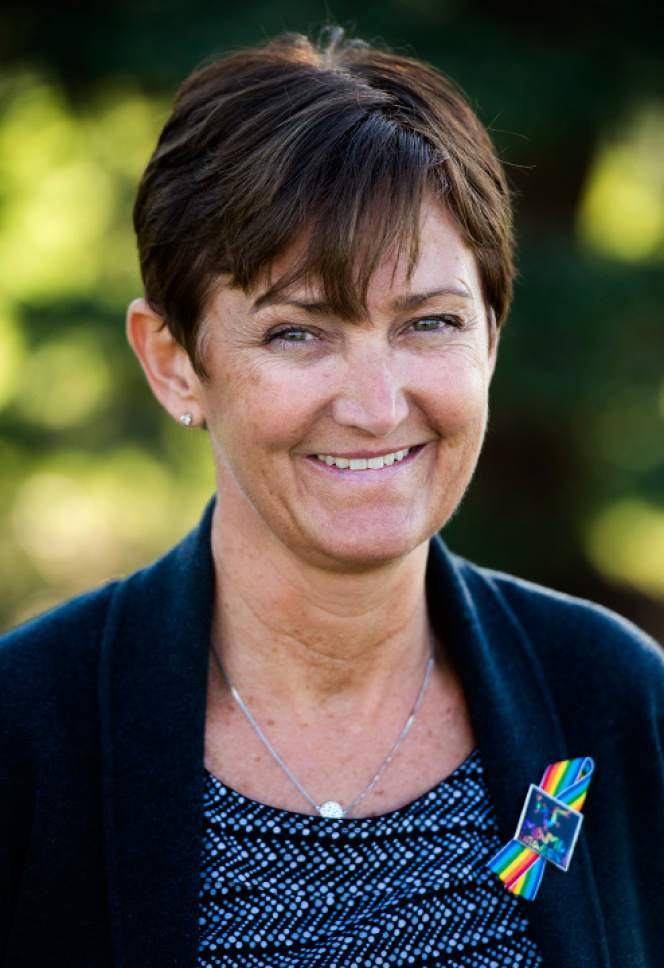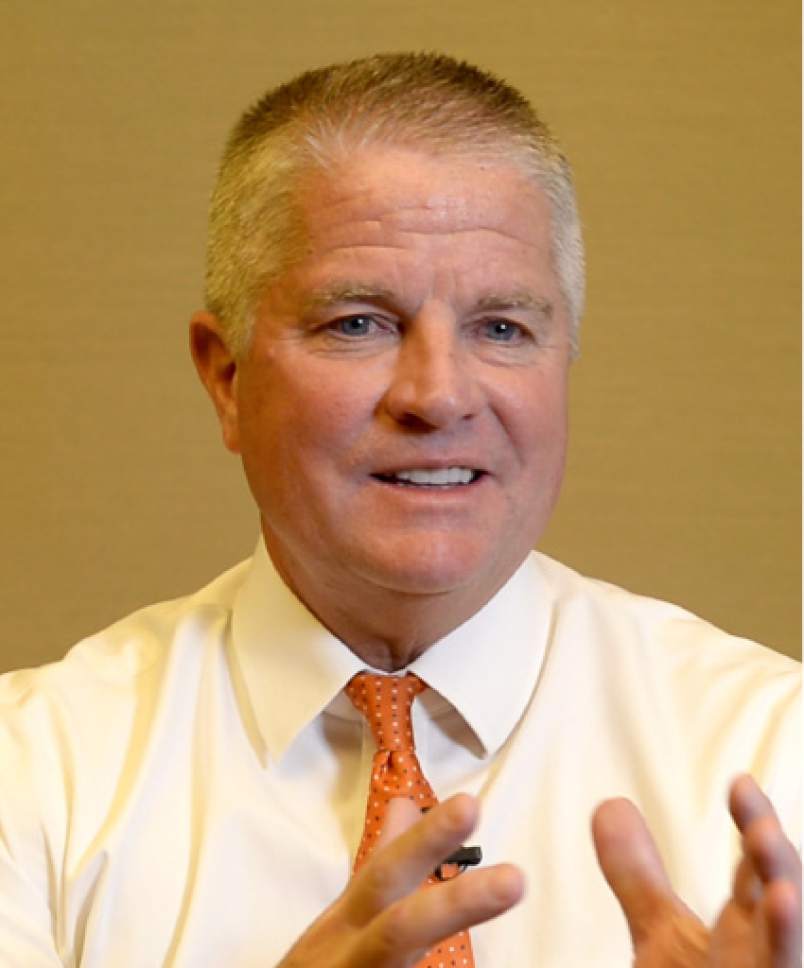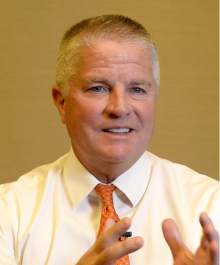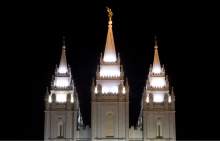This is an archived article that was published on sltrib.com in 2016, and information in the article may be outdated. It is provided only for personal research purposes and may not be reprinted.
The LDS Church's policy on gay couples was meant as an act of compassion to protect families from conflicts, yet for some the news — which leaked out Nov. 5, 2015 — did the opposite.
In the year since it became public, the stance — branding same-sex Mormon couples as "apostates" and banning their children from baby blessings and baptisms until they are 18 — has created pockets of pain among Latter-day Saints the world over.
The policy produced rifts between opponents and supporters, agonized questions of identity and community, public resignations and private tears, heartfelt decisions about whether to stay involved in the faith or walk away.
A leader in a Utah LDS ward, or congregation, was stunned by his church's move, describing it as "a sucker punch to my gut by a member of my own team."
In response, thousands of critics, including many who had long since stopped participating in the church, expressed dissatisfaction by joining rallies and social media debates. Others stopped paying tithing, turned in temple recommends (allowing them access to the faith's holiest rituals), refused to serve in volunteer positions or left the church altogether.
The number of gay Mormons who have ended their lives has increased, advocates say, and so has the incidence of depression. In a Seattle-area LDS ward, 15 LGBT members were attending regularly before Nov. 5; now only a handful are.
"From the moment I heard the words of the policy, I felt they lacked any love, compassion or empathy," says Salt Lake City resident Carlin Briggs, a Mormon convert and a three-time women's Relief Society president in her congregation. "It sounded like it was written by lawyers and not from a loving God."
Briggs and her husband have since turned in their temple recommends and no longer pay tithing. They cannot "support a church that is so hurtful to families," she says. "We no longer attend meetings, but have not resigned [their memberships]."
Some have stayed in the fold but are speaking up.
"I went to my bishop to tell him I don't agree with it and asked, 'Do you need my temple recommend?' " Dana Conway says. "He didn't share my level of concern but said I could keep my recommend."
The policy issue has pushed the Sandy woman into asking more questions.
"This just seemed so out of sync with everything the church has been doing for gays recently and with the gospel as a whole," explains the Utah mother and Brigham Young University graduate who describes herself as "100 percent in" the faith. "I am not willing to silently sit there and pretend I agree with the policy, which I believe is harmful."
This policy marked the first time some Mormons had ever disagreed with their LDS leaders on a major issue, triggering a kind of moral crisis or, at least, a readjustment in their devotion to the men who lead the 15.6 million-member Church of Jesus Christ of Latter-day Saints.
Even Marlin K. Jensen, an emeritus Mormon general authority who backs the hierarchy and the policy, acknowledges he was initially troubled by it.
It has "damaged" church members, Jensen told a packed audience last month at the 50th anniversary celebration of Dialogue: A Journal of Mormon Thought. "It represented a serious setback in many quarters, which is regrettable and will take some time to repair."
Even so, many Mormons, perhaps most, see no conflict.
"An essential part of being LDS is accepting the members of the [governing] First Presidency and Quorum of the Twelve Apostles as actual prophets and representatives of the Lord," Syracuse resident Brandon Bowen says. "If I were to believe they were wrong about any particular policy, that would create an apparent (logical) conflict with my acceptance of them as true prophets to begin with."
Accepting the policy is, Bowen says, simply a fact of his faith.
—
Law of the land vs. law of the church • The "gay policy" was created as a directive to the LDS Church's vast lay clergy. When it became public, a firestorm ensued.
So, on the evening of Nov. 6, LDS apostle D. Todd Christofferson gave a hurriedly thrown together interview in which he explained that the change was prompted by the U.S. Supreme Court's ruling legalizing same-sex marriage.
"There was a need for a distinction to be made between what may be legal and what may be the law of the church and the law of the Lord," the apostle says. "We regard same-sex marriage as a particularly grievous or significant, serious kind of sin that requires church discipline."
Christofferson, whose brother is an openly gay believing Mormon, then says barring children of same-sex couples from religious rites until they are 18 is born of "compassion."
"It originates from a desire to protect children in their innocence and in their minority years," he says. " ... We don't want the child to have to deal with issues that might arise where the parents feel one way and the expectations of the church are very different."
It parallels the way the LDS Church has treated children of polygamists, he says, after the Utah-based faith gave up plural marriage more than a century ago.
"This is the other shoe dropping," says Kathleen Flake, a historian who oversees Mormon studies at the University of Virginia. "The LDS Church can accept same-sex marriage as a civil right, but not within the church."
What to do with same-sex Mormon couples apparently became a problem for LDS bishops, who needed instruction on how to implement the faith's position.
"For Latter-day Saints, there is only one kind of [approved] sexual cohabitation — that is between a man and a woman in a civilly recognized marriage," Flake says. "Polygamy and same-sex marriage are both forbidden."
This policy was designed to "clarify the moral ambiguity created by legalizing same-sex marriage," she says. "It became morally good for most Americans when it became legal; but legalization did not make it moral in the eyes of some religious believers, including Mormons."
Allowing same-sex pairs to be treated as equal to heterosexual couples, Flake says, would undermine the church's position on marriage, which LDS theology teaches can extend into eternity.
To some Latter-day Saints, though, the most troubling aspect of the policy involves the children.
—
About the grandkids • A basic belief in Mormonism — codified in the second of its 13 Articles of Faith — is that people will be punished for their own sins and not for those of their ancestors or parents. This policy, for some, contradicts that tenet.
With parental permission, Mormons baptize the children of murderers, adulterers and con artists, the argument goes, so why single out the kids of gay couples?
"It feels to many like their grandchildren are being sacrificed on the altar of the church's doctrinal position," says Patrick Mason, head of Mormon studies at Claremont Graduate University in Southern California.
A Mormon father who has a lesbian daughter is among those worried about future progeny.
"With this new policy, the church is taking away agency from families and children," Herriman resident J. Bradley Simons writes. "If my daughter has children and I, as their grandpa, want to provide them with blessings and opportunities in the church — with my daughter's permission — I am precluded from that course of action."
How, he wonders, could the religion he cherishes deny his offspring the very things that built his own character?
The church promises these children "will not miss out on anything and can join, after having abandoned their home and family, when they are 18," he says. "But much of what makes me who I am today was developed in [LDS youth programs]. To say that they are not affected by being excluded … is a fable and flat-out misrepresentation of real life."
—
At the grass roots • LDS officials last week unveiled a new website, mormonandgay.org, that features video clips of gays and lesbians sharing their personal journeys as they grapple with their spirituality and sexuality. The site includes counsel from LDS leaders, noting that the church is open to all and encouraging members to be welcoming to everyone.
The materials do not, however, mention the policy, and the church declined to detail how it has been carried out in thousands of Mormon congregations both in the U.S. and abroad.
Observers say inconsistencies have surfaced from ward to ward as believers seek inspiration and insight on how to handle complicated relationships.
In a Maryland ward, for instance, a young man who had already been baptized was not ordained to the all-male Mormon priesthood when he turned 12. It was just after the policy was put forth, and he was living with two moms during the school year. In the summer, he and his sister stay with their dad, who remains an active Latter-day Saint.
"Our leadership at the time wanted to go ahead and ordain him, but it was blocked at the stake level. Mom was very upset," reports a leader in the congregation's Primary organization for children.
"Though she had 'left the church,' she had been making an effort to bring them for years. Some people advocated for just doing the ordination and 'asking forgiveness later.' "
It was a dilemma for ward leaders.
"No one was willing to say anything in defense of the family for fear of, essentially, going off script or falling out of line, appearing less than faithful," the member writes. "These were children we knew, taught and loved. Children we made an extra effort to support because of their situation. I helped prepare this child to receive the priesthood and then had to take it all back. It was sad."
—
"Marginalized" • Not a day goes by when Sue Bergin, a Relief Society president in Provo, doesn't think about the policy.
"I hear so much angst among my LGBT friends and family who want to sit in the pews and feel welcome and embraced," Bergin says.
"As an older, single LDS woman, I know what it's like to feel marginalized. My experience doesn't approach that of my LGBT brothers and sisters, but it does help me walk that borderland with them and try to empathize and include and love without condition or judgment."
The morning after he heard the news, Minneapolis resident John Gustav-Wrathall fell to his knees in prayer and felt a sense of peace.
"I felt God was telling me, 'I'm gonna work this out — and you're OK,' " recalls the president of Affirmation, a support group for gay Mormons and their loved ones. "The next Sunday at church, there was a line of members waiting to greet and hug me."
Others were not so lucky.
"I felt like a field medic," Gustav-Wrathall says, "trying to bandage so many people who were hurting."
Affirmation's Ron Raynes of Eugene, Ore., has been tracking the fallout among LGBT members, their families and allies in the year since the policy emerged. The group received more than 900 self-reported survey responses, he says, and they point to a worrisome trend.
Not surprisingly, "drop-off rates" — Mormons losing faith or discontinuing involvement — were even higher for the Affirmation community as a whole.
"As you can well imagine," Raynes says, "the policy impact has been a source of alienation and departure for a broad spectrum of our community."
What was unexpected, he says, was that "generally speaking, the straight (non-LGBTQ) respondents had higher drop-off rates than the LGBTQ respondents."
—
Loss of moral authority • Gay Mormons and their allies who want to stick with the faith have always presumed that there were a few voices in the top echelons they could count on, LDS leaders who would defend them — or at least not hurt them.
"When this happened, such members were forced to concede either those voices are not there, they refuse to speak up or are too weak to oppose this," says Mason, the Claremont scholar. "Either way, there's been a near complete loss of trust in the senior leadership."
In January, Russell M. Nelson, senior apostle and next in line to lead the global church, declared that the policy was a divine revelation, endorsed by God and confirmed by all 15 members of the governing quorums.
That did not seem to square with the narrative first presented by Christofferson, Mason says.
"People looking at this critically and carefully did not see a unified front in Salt Lake. It was not the well-coordinated and well-considered effort they are used to seeing."
When Brad Kramer, a Mormon anthropologist in Provo, first learned about the policy, he was "distraught and angry and disappointed."
"The policy change and some of what church leaders did in the following weeks and months impacted me in a way that nothing else ever has," Kramer says. "It deeply damaged my relationship with church leaders. It damaged my trust in them."
For his part, Mason says he has not talked to any Mormons "who feel they have been helped by the policy."
No member has said how the policy "helped me in my job, be a better Latter-day Saint, come closer to God, helped me with my family," the scholar recounts. "I haven't heard any functional or utilitarian defenses of it."
—
An LGBT ward? • Richard Ostler, a former bishop of a ward for single Mormons in Magna, has taken on the task of providing solace and a listening ear to gay and lesbian members who contact him all hours of the day or night.
"I have met with a lot of people, including gay kids, who are really hurting," he says. "I just mourned with them about the policy."
Today's church is an early chapter in the story of Mormonism's relation to its LGBT members, he reasons. More could be written without changing doctrine.
For example, how about creating Mormon congregations exclusively for gay members? Ostler wonders. This could be wards for lesbian, gay, bisexual and transgender individuals and maybe some straight allies.
Such a ward would be "a safe and welcoming place for those in the LGBT community who consider the LDS Church their spiritual home," he says. "Like our singles wards, all would be welcome regardless of commandment-keeping or the depth of testimony."
Being bishop of such a ward would be Ostler's "dream calling."
For now, he's just ministering to this community. "It's what God wants me to do."
Tribune reporter Jennifer Dobner contributed to this story. This story also was informed by sources in the Utah Public Insight Network. To become a news source for The Tribune, go to http://www.sltrib.com/upin.
pstack@sltrib.com Twitter: @religiongal









